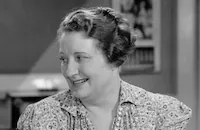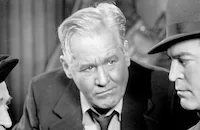Babes in Arms

Brief Synopsis
Cast & Crew
Busby Berkeley
Mickey Rooney
Judy Garland
Charles Winninger
Guy Kibbee
June Preisser
Film Details
Technical Specs

Synopsis
When vaudeville is eclipsed by the motion picture, Mickey Moran's parents, vaudeville troupers Joe and Florrie Moran, find bookings scarce. However, Mickey, who was born backstage at New York's Palace Theatre, remains undaunted and determines to write a show to be presented by the kids of the old vaudevillians in his hometown of Seaport, Long Island. In order to reach his goal, Mickey has to contend with many adversities, among which are the threats of Martha Steele, the head of the welfare board, who wants to send the youngsters to work school; the temperamental ego of Baby Rosalie Essex, the child star who is bankrolling the show; and the jealousy of Patsy Barton, his girl friend, who sees a rival in Baby Rosalie. Mickey manages to overcome all these problems, but is unable to control the weather when a hurricane washes away the show in mid-performance. Just when things look their blackest and Mrs. Steele is about to swoop the children off to work school, Mickey receives word that Harry Maddox, a New York producer, has decided to stage the show on Broadway.

Director

Busby Berkeley
Cast

Mickey Rooney

Judy Garland

Charles Winninger

Guy Kibbee

June Preisser
Grace Hayes

Betty Jaynes

Douglas Mcphail

Rand Brooks
Leni Lynn

John[ny] Sheffield

Henry Hull
Barnett Parker

Ann Shoemaker

Margaret Hamilton

Joseph Crehan

George Mckay
Henry Rocquemore
Lelah Tyler
Lon Mccallister
Ann Bupp
Crew
Harold Arlen
Leo Arnaud
Gus Arnheim
George Bassman
Eubie Blake
Robert Bradford
Tex Brodus
Nacio Herb Brown
Roger Edens
Arthur Freed
Arthur Freed
Cedric Gibbons
E. Y. Harburg
Lorenz Hart
Ray June
Noel Langley
Eddie Larkin
Eddie Leonard
Abe Lyman
Jack Mcgowan
John Meehan
Merrill Pye
Richard Rodgers
William Ryan
Florence Ryerson
Douglas Shearer
Noble Sissle
Art Smith
George Stoll
Frank Sullivan
Dolly Tree
Kay Van Riper
Edwin B. Willis
Edgar Allan Woolf

Photo Collections
Videos
Movie Clip




Trailer
Hosted Intro
Film Details
Technical Specs

Award Nominations
Best Actor
Best Score
Articles
Babes in Arms
Arthur Freed got his start writing and performing in New York vaudeville, before being signed to write songs for MGM's new musical department in 1929. His early efforts included writing lyrics for songs in The Hollywood Revue (1929), which introduced the songs "Singin' in the Rain" and "You Were Meant For Me." Both songs were co-written with Freed's frequent partner, Nacio Herb Brown. Freed's tunes were also heard in Bing Crosby's Going Hollywood (1933), The Broadway Melody of 1936 (1935) and in Freed's first outing with Garland and Rooney for Thoroughbreds Don't Cry. However, Freed's career would soon encompass more than just songwriting.
In 1939, Arthur Freed was given a test assignment on a little project called The Wizard of Oz. Not only would Freed serve as associate producer for the film, he'd come to play an instrumental part in shaping and preserving an unforgettable piece of Americana - Garland's on-screen rendition of "Over the Rainbow." As the Hollywood legend has it, the producers of The Wizard of Oz and MGM head Louis B. Mayer wanted to cut "Over the Rainbow" from the movie, saying it slowed the story down. But Freed insisted the song stay in, remarking, "the song stays or I go." Freed, of course, got his way. And soon after, his own musical production department at MGM.
Based very loosely on a hit Rodgers and Hart play of the same title, Babes in Arms would be Freed's first project under the watch of his new unit. The movie retained only three of the show's original songs - the title song, "The Lady is a Tramp" and "When or Where." The movie's plot was also changed significantly from the stage version, to enhance Mickey Rooney's part, but still maintained the basic audience-pleasing formula of some talented kids putting on a show. Freed added some of his old tunes to the adaptation including "You are My Lucky Star" and "I Cried For You." He and Brown wrote "Good Morning" especially for the movie. And Oz songwriters E.Y. Harburg and Harold Arlen (who'd written "Over the Rainbow" as well as "If I Only Had a Brain" and "We're Off to See the Wizard") were called in to write "God's Country" for the big finale.
Freed and Garland had just completed The Wizard of Oz when filming began on Babes in Arms on May 12, 1939. In fact, Freed was still wrapped up in edits of The Wizard of Oz and his battle for Over the Rainbow all through the Babes in Arms shoot. July 18, 1939 turned into quite a big day for Freed. Primary production wrapped on Babes in Arms and the first preview of The Wizard of Oz was screened. "Over the Rainbow" was an instant success. But it hadn't all been smooth sailing on Babes in Arms. It seems Garland and director Berkeley didn't get along terribly well, and that the young star had trouble keeping up with co-star Rooney's energy. Some Garland bios claim she was already on diet pills at this time.
Still, Babes in Arms opened to enthusiastic reviews. It was a vindication for Berkeley who proved he could change with the times and create a hit even without his signature production numbers. Variety's review noted Berkeley's direction saying, "He blends drama, comedy and musical episodes into a fine composite of mass entertainment." Mickey Rooney was nominated for an Oscar for his part, which the actor later said "may have been the best picture I ever made." Judy Garland got her hands and footprints set in cement outside Grauman's Chinese Theater to mark the Babes in Arms premiere. And she was awarded a special Oscar that year "for her outstanding performance as a screen juvenile for the past year."
As for Freed, he became synonymous with MGM's integrated musical and would go on to produce such crowd pleasers as Meet Me in St. Louis (1944), Singin' in the Rain (1952) and Gigi (1958). Babes in Arms would be a triumphant beginning for his new musical unit, costing around $600,000 to make and taking in over 2 million dollars domestically to become one of MGM's biggest grossers of 1939. And best of all, the movie led the way for many other Freed productions, that just like Babes in Arms would be what Variety called "topflight filmusical entertainment."
Producer: Arthur Freed
Director: Busby Berkeley
Screenplay: Jack McGowan, Kay Van Riper (based on the play by Lorenz Hart, Richard Rodgers)
Music: Harold Arlen, Nacio Herb Brown, Bob Carleton, George M. Cohan, Roger Edens, Ernie Erdman, Arthur Freed, Lorenz Hart, Richard Rodgers
Cinematography: Ray June
Art Direction: Cedric Gibbons
Cast: Mickey Rooney (Mickey Moran), Judy Garland (Patsy Barton), Charles Winninger (Joe Moran), Guy Kibbee (Judge Black), June Preisser (Rosalie Essex), Grace Hayes (Florrie Moran), Betty Jaynes (Molly Moran), Henry Hull (Maddox).
BW-97m. Closed captioning. Descriptive Video.
by Stephanie Thames

Babes in Arms
Quotes
Trivia
Notes
In a montage in the first reel of the film, clips from the 1929 M-G-M musical Broadway Melody are shown. In these sequences, Robert Bradford dubs the singing voice of Charles E. King in the song "Broadway Melody," and Tex Brodus dubs the singing voice of Cliff Edwards in "Singing in the Rain." Scenes of Mickey Rooney as a young child, taken from earlier screen appearances, are included, indicating the passage of time from his babyhood to teenaged years. A pre-production news item in Hollywood Reporter notes that Mervyn LeRoy was to replace Arthur Freed as solo producer and Freed was to be relegated to the role of associate producer. According to an early draft of Screen Achievements Bulletin, Noel Langley and John Meehan were contributing writers, but the exact nature of their contribution is not known. This picture marked Busby Berkeley's debut as an M-G-M director. The film also marked actress June Preisser's screen debut. A news item in Hollywood Reporter adds that M-G-M planned to groom actress Grace Hayes for Marie Dressler-type roles. Rooney was nominated for an Academy Award as Best Actor for his role in this film, but lost to Robert Donat for Goodbye Mr. Chips. Modern sources state that the ending of the film in which Rooney spoofs Franklin D. Roosevelt in the production number "God's Country" was removed in a 1948 reissue of the film and never restored. The viewed print, a current video release of the film, includes the spoof, however. In 1941, M-G-M produced the musical Babes on Broadway, which was also directed by Berkeley and starred Rooney and Garland.

Miscellaneous Notes
Released in United States 1939
Released in USA on video.
Released in United States 1939
















